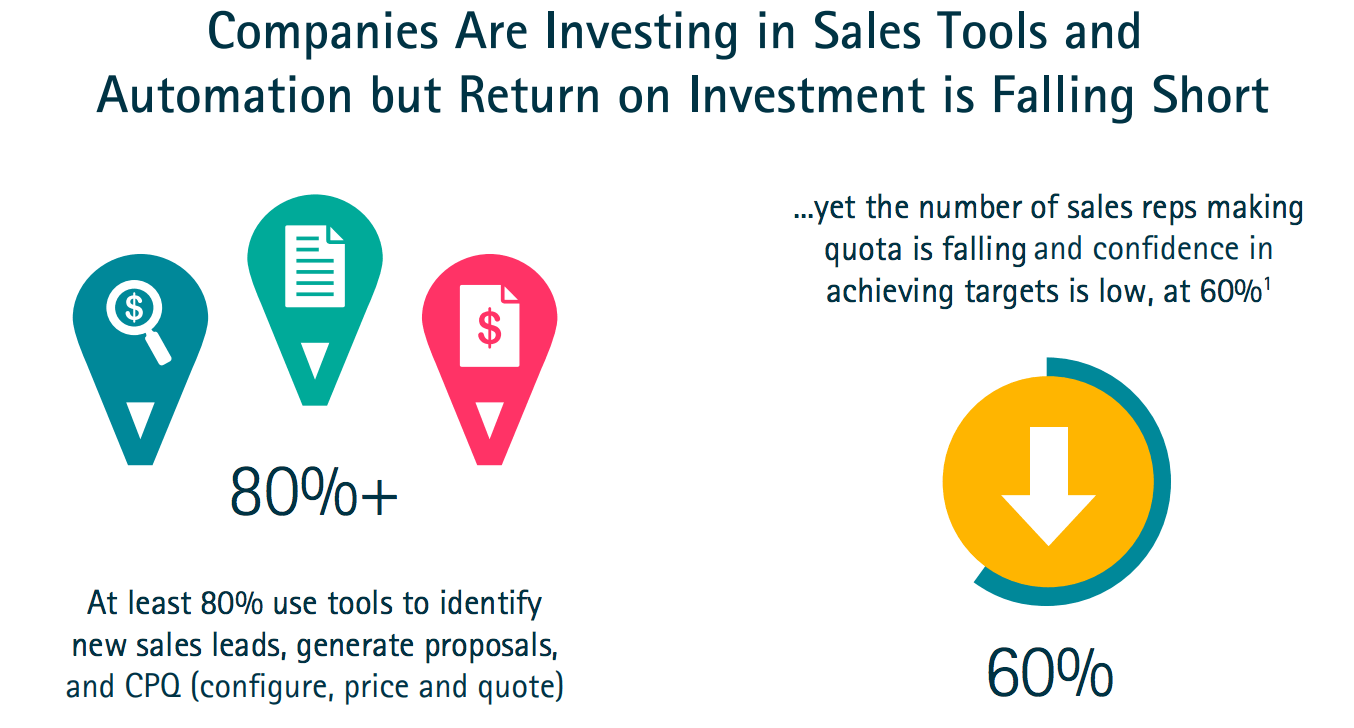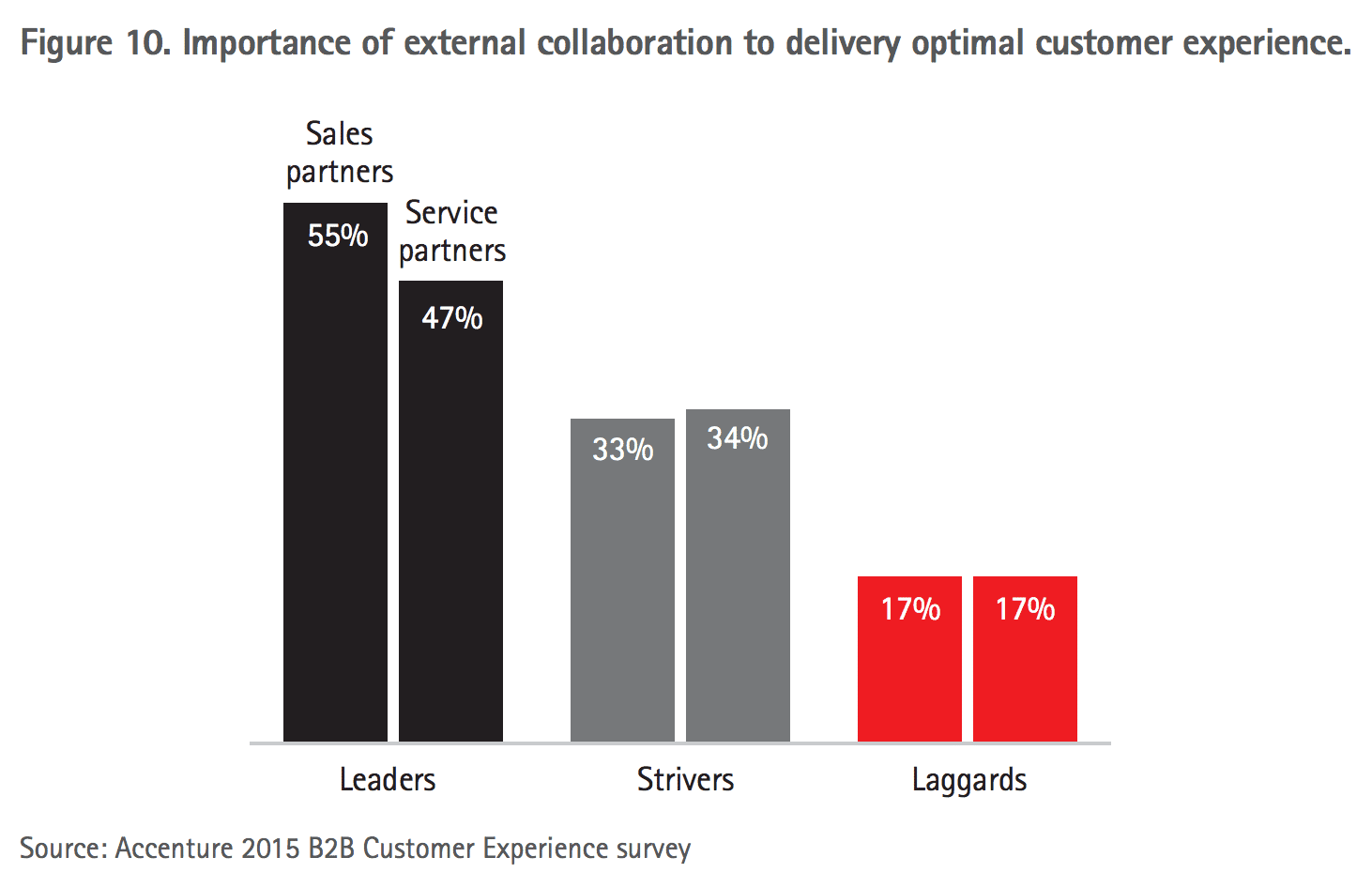
Sales enablement refers to any technology solution designed to increase productivity during the sales cycle, usually for enterprise business development. Whether managing many sales reps in a large organization or increasing a single sales executive’s conversion rates, the primary goal of sales enablement is to push productivity numbers up and to the right.
In this article we’ll explore two important questions that business leaders are already asking about machine learning in sales enablement:
- What new capabilities does AI allow for in a sales enablement software?
- What questions should IT and sales leaders ask when they’re looking for a sales enablement software?
We’ll tackle both of these questions in the sub-sections that follow, and we’ll also share quotes and perspectives from three tech salespeople on the pros and cons of AI in for sales enablement. By the end of this article you’ll have a better idea of AI’s sales applications, and if / where those applications might fit in your own organization.
To begin, we’ll take a look at the abilities that AI enables:
Sales Capabilities that Machine Learning Allows For
Machine learning has a clear role to play in automating or enhancing the following sales business processes:
- Lead generation – Create contact lists for outbound communication (automated web scraping or filtering)
- Lead cleansing – Verify that contact data is accurate (automatically referencing existing CRM data with new updates across various outside / inside information sources)
- Responsive email cadence automation – Automatically follow up with unresponsive leads using targeted campaigns that vary depending on the lead’s behavior, or CRM data points about the lead itself (i.e. companies like Conversica)
- Sales script optimization – Use machines to learn the phrases, cadence, and processes of the best salespeople in an organization, and model / teach those skills to lower performing salespeople
- Sales forecasting – Leveraging CRM data, current activities, and historical performance to predict sales performance (i.e. companies like InsideSales)
- Sales content optimization – Ensure reps have best content for customer personalizing their upcoming sales meeting (automatically matching a lead’s profile with the sales material most likely to convince that particular lead)
- Quote generation and order processing – Speed buying decisions and hand-off process
It’s important to note that many current sales enablement technology solutions do not yet need to use machine learning in any significant fashion. Salesforce only recently pushed forward with it’s Einstein application, and our research indicates that most of the startups in the “AI for sales enablement” space are less than three years old.
With or without ML, the goal for these solutions is to eliminate or decrease time that sales reps and account managers spend on administrative and order processing tasks.
As it turns out, “selling” represents only about a third of the time of most salespeople, according to Salesforce Research:

The next few years will likely see an arms race re-shape the industry, as early adopters test new solutions and deploy them at scale to gain an enhanced competitive edge. Where can machine learning drive the biggest productivity gains for sales enablement solutions?
One might ask, “Isn’t selling fundamentally about building human relationships?” Certainly much of the function of selling involves in-person interactions and relating to others – skills that likely won’t be modeled in machines anytime in the next ten years.
Top AI sales enablement solutions, therefore, will give sales professionals more time to be effective in the field, making more of the right calls and having face-to-face conversations, while spending less time on rote tasks that machines do better or faster.
The challenge for any business looking to drive ROI through an enhanced sales tech stack will lie in identifying the true disruptors from companies who may be simply moving the sales workflow from one CRM to another.
Adding productivity tools to a sales professional’s workflow — even if those tools are machine learning-driven — does not always equal productivity gains. One estimate from SiriusDecisions suggests that the current rep uses up to nine separate tools in the course of a normal sales cycle. The same estimate suggests that there are at least 500 vendors offering some kind of sales enablement solution, many of which could be used in tandem.
The danger of tool proliferation is real – a workflow that is too fragmented can negatively impact productivity, which was the only reason to introduce new tools in the first place.

While the competitive imperative to increase sales productivity demands is real, so too is the danger that comes with on-boarding too many solutions, or on-boarding solutions that don’t maximally impact the bottom line. The danger is magnified when different solutions run the risk of creating new data silos that prevent leaders from seeing the complete picture of sales professionals workflow.
If a key conversation or piece of outreach is captured in a silo with low visibility, it can negatively distort the top-of-funnel performance metrics of a sales professional when they are actually focusing on what’s important to close a deal. Discussing the danger of process fragmentation, Business Process Management Institute notes:
“Processes in a fragmented organization are like a convoluted system of poorly-joined plumbing, with pipes that leak time, money and customer value. Core business transactions are disintegrated and re-integrated numerous times on their way to the customer. There are a number of variables that contribute to this problem of fragmentation.”
What we learned from talking to sales professionals is that the most important way that machine learning and AI can drive sales enablement is essentially a Goldilocks problem: Automation drives productivity, but too much automation in the wrong places can negatively impact the overall sales workflow, not to mention the customer experience.
Much depends on how far along an organization is in implementing CRM best practices into their overall customer experience. Content is a great example; some estimates suggest that sales reps can spend up to 30 hours a month finding the right content to push to their prospect. Solutions that organize and push content to reps that aligns with a customer persona can get those hours back into productive use. As SAVO’s Mary McGuire notes: “…predictive content recommendations is the primary use case for machine learning within Sales Enablement technology.”
A recent study on sales enablement optimization suggests that personalizing sales content is the most significant driver of quota attainment and win rates, including white papers, customer case studies and references. That includes content for social selling on platforms such as LinkedIn, Twitter and Facebook, where enterprise content can define the interaction.
As business leaders think through the future of their own sales process, it’s important that they ask questions of both sales enablement vendors and their internal sales staff. We’ve out together a series of “starter” questions that might inform a company’s sales technology needs (these questions are informed by the sales professionals who are quoted at the end of this article).
Five Important Questions to Ask When Choosing a Sales Enablement Software
To help organizations sort the best from the rest, we put together five A/B questions for business managers to think about when integrating machine learning into their sales enablement stack:
- Does the solution provide unique or proprietary data or is it one of many sources of publicly available or generic data for leads?
Why this is crucial: Ben Narasin at Canvas Ventures has called data “the new oil”, and a strong offering of lead and prospect data forms a key value proposition for many sales enablement solutions. However, not all data is created equal. As anyone who has tried reaching out using an expired lead list will tell you, real-time proprietary data sources is likely a key factor in how much teams will rely on sales enablement tools. The best machine learning in the world won’t make a difference if the lead data that it’s pulling isn’t high-quality.
Our interviews indicate that investors are increasingly more receptive to companies with a compelling way to leverage data to gain a better and better competitive advantage over time. Sales managers and executives may also see value in working with the companies who are likely to win the sales enablement technology war, and we can presume that leveraging data will be more and more important here.
In our recent interview with Gary Swart of Polaris Partners, he summed up the changing dynamic of data in enterprise software well:
“…historically it was about aggregating, scrubbing, de-duping, etc. and everybody claimed to be doing AI, but I think now what we’re seeing is the data is made actionable, and companies are developing effective methods for unsupervised learning.” – Gary Swart, Polaris Partners
- Does the solution live in current team’s workflow or does it require a separate login and/or user experience?
Why this is crucial: The appeal of personalizing outreach via a CRM is obvious, yet (as with any collaboration management technology) team adoption can often present a challenge. To ease on-boarding friction and lower time to quota attainment, best sales enablement solutions will use machine learning to remove part of an existing workflow, rather than asking sales professionals to reinvent the customer experience end-to-end.
- Does the solution add context to a conversation in way that is personalized rather than customized?
Why this is crucial: The quantity of content that sales teams have at their disposal for moving conversations forward has never been higher. Now the challenge is making sure that individual sales professionals have the right content for the right conversation, and that they don’t spend forever locating and retrieving it, particularly during a virtual or live interaction.
As machine learning allows sales enablement tools to pull and structure an ever-increasing percentage of a prospect’s social media footprint, teams can look to add value by starting conversations with personalized notes generated or informed by machines.

- Does the solution drive outreach to prospects who are not being currently contacted or does it simply put yet another email in an already overfull inbox?
Why this is crucial: The next wave of sales enablement technology will focus on reaching decisionmakers who haven’t already been emailed a hundred times a day for most of their professional lives. Targeting the correct lead is ultimately what determines if that lead will respond, and whether that response is likely to lead to a sales meeting.
Reaching high-visibility prospects, even with a personalized email, may not be very effective if they are already overwhelmed with inbound communications. Solutions that have greater mobility across verticals and sectors will rise to meet this challenge.
- Does the solution drive real conversion rates or are its highest-performing metrics high-level proxies?
Why this is crucial: Since making decisions based on performance data has by now become quite fashionable, the real question now is what data you ought to use to measure success, inform strategy and so on. The question of metrics, therefore, is all-important. For example, metrics for an email outreach campaign typically included opens, click-throughs and conversions.
How many people open an email, how many of those click the link, how many of those end up making a purchase? This winnowing process in email marketing indicates what people mean by “funnel”, whereby many leads become fewer prospects, and then some of those prospects end up converting and becoming customers. Until a solution pushes the number of deals closed up and to the right, its ROI claims remain purely speculative, regardless of any other metrics it might boast.
Sales Experts Weigh In on the Value of AI for Sales Tools
In order to ground our questions and insights in advice from real sales professionals. So we reached out to three tech salespeople to get their perspective on selecting sales software, and the value of AI in sales tools.
We hope that these comments will add color to the conversation and help sales leaders inform their own technology choices.

1 – Albert Alexander – Sales Operations Manager at Dynamic Signal
Of these, the most important I think is context vs content.
For impersonal, administrative, non-sales content (i.e. filling in company name or knowing that 3 days from now is a Tuesday), AI is great.
But for the real meat of a sales email, AI is terrible and untrustworthy.
AI should not sell.
AI should make selling easier.
The less time reps spend clicking around (including within your tool!) the better: reps are paid to sell, not administrate tools.

2 – Jacob Miller – Account Manager and Team Lead at Growbots
“While all of these questions are important to consider in an evaluation, I would argue that question # 5 is the most integral to assessing anticipated ROI. All too often in my conversations with buyers, a common refrain will be something like, ‘well we got hundreds of ‘engagements’ or high-score leads but we realized after 6 months we had only booked one meeting from our entire lead gen efforts’.
If the metrics you’re using to measure campaign success are actually distracting from the actual impact on your top-line revenue goals, then they are worse than useless, they are actually harmful.
In my view, any sales automation platform should be able to evidence two tangible pieces of value:
1) Quantifiable time savings, i.e. ‘We used to spend 4 hours a day per rep on manual list building’, and
2) SQL conversion rate/volume, i.e. ‘We contact 1000 prospects per month and generate on average, 35 SQLs / meetings booked’.
Each of these can be tied to an actual ROI in terms of cost savings or revenue generated for the business, which should be the ‘true north’ goal of any evaluation, of any product!”

3 – Edward Oser – Client Development at Be-novative
“The most important aspect of any sales solution is whether it makes one of the following processes easier:
1) Identifying the potential deal or contact person
2) Engaging with that person
3) Tracking interactions
4) Finding out what are the key elements of the deal they care about and finally
5) Closing the deal
Everything else is nice to have, but only as features of a solution that creates value in one of those key areas.”
Concluding Thoughts on Machine Learning for Sales Enablement
Expect to see robust proliferation of both vendors and solutions for sales enablement solutions over the next few years, many of whom may claim to use machine learning as part of their secret sauce. The question of whether or not machine learning will push productivity numbers up and to the right will depend entirely on where they are applied in the sales cycle, and where in a given organization the biggest gains are left to be realized.
The best way to answer this question for a given organization is to map the process of sales professionals to determine what activities outside of selling suck away their time, then focus on automating those activities. For sales enablement solutions, the sales process and the customer experience must be used to assess a given technology, not vice-versa.
Companies most poised to benefit from machine learning in sales enablement are those who (a) have relatively high transaction volumes, (b) have large sales forces, and (c) have the majority of their marketing and sales activity tracked via some digital process (i.e. digital marketing and CRM systems that track all or most of a prospect’s touch-points up through – and after – a closed sale).
Many of the AI marketing startup executives that we’ve spoken with have echoed this same notion of “he who has the most data (and his data in order!) will benefit most from AI” over and over:
“It’s the amount of data you have on those users. Data is really the lifeblood of most AI algorithms, and the more data you have on those users across a broader set of users, the more effective these algorithms and technology are really going to be…” Alex Holub, CEO of Vidora
For better or for worse, this reality tends to favor larger tech-savvy firms as the initial adopters of these technologies (not small startups with a handful of salespeople).
Companies on the fence about sales enablement AI should take stock of their own sales operations to see if the features that AI allows for are in fact crucial for their business operations today or in the near future.
Image credit: Morguefile







